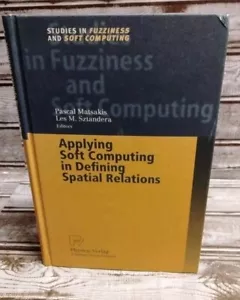Picture 1 of 8








Gallery
Picture 1 of 8








Applying Soft Computing in Defining Spatial Relations Hardcover by Matsakis
US $39.99
ApproximatelyPHP 2,233.40
or Best Offer
Condition:
Like New
A book in excellent condition. Cover is shiny and undamaged, and the dust jacket is included for hard covers. No missing or damaged pages, no creases or tears, and no underlining/highlighting of text or writing in the margins. May be very minimal identifying marks on the inside cover. Very minimal wear and tear.
Oops! Looks like we're having trouble connecting to our server.
Refresh your browser window to try again.
Shipping:
Free USPS Media MailTM.
Located in: Tampa, Florida, United States
Delivery:
Estimated between Tue, 6 May and Mon, 12 May to 43230
Returns:
30 days return. Seller pays for return shipping.
Coverage:
Read item description or contact seller for details. See all detailsSee all details on coverage
(Not eligible for eBay purchase protection programmes)
Seller assumes all responsibility for this listing.
eBay item number:296614628384
Item specifics
- Condition
- Book Title
- Applying Soft Computing in Defining Spatial Relations
- ISBN
- 9783790815047
About this product
Product Identifiers
Publisher
Physica-Verlag
ISBN-10
3790815047
ISBN-13
9783790815047
eBay Product ID (ePID)
2292538
Product Key Features
Number of Pages
Xiii, 205 Pages
Language
English
Publication Name
Applying Soft Computing in Defining Spatial Relations
Publication Year
2002
Subject
Earth Sciences / Geography, Intelligence (Ai) & Semantics, Life Sciences / Anatomy & Physiology (See Also Life Sciences / Human Anatomy & Physiology), Data Processing, Logic
Type
Textbook
Subject Area
Mathematics, Computers, Science
Series
Studies in Fuzziness and Soft Computing Ser.
Format
Hardcover
Dimensions
Item Weight
38.8 Oz
Item Length
9.3 in
Item Width
6.1 in
Additional Product Features
Intended Audience
Scholarly & Professional
LCCN
2002-029042
Dewey Edition
21
Series Volume Number
106
Number of Volumes
1 vol.
Illustrated
Yes
Dewey Decimal
005.1
Table Of Content
Fuzzifying Spatial Relations.- 1 Motivation.- 2 Imprecision in Spatial Relations.- 3 Applying Allen's Algorithm to Fuzzy Relations.- 4 Other Fuzzy Relations.- 5 Fuzzy Constraint Satisfaction.- 6 Conclusion.- Acknowledgement.- References.- Path Composition of Positional Relations Integrating Qualitative and Fuzzy Knowledge.- 1 Introduction.- 2 Composition of Positional Relations.- 3 Path Composition.- 4 Integrating Qualitative and Fuzzy Knowledge.- 5 Fuzzy Knowledge Coming from Particular Distance Systems.- 6 Conclusions.- Acknowledgments.- References.- Spatial Relations Based on Dominance of Fuzzy Sets.- 1 Spatial Relations.- 2 Spatial Relations Among Fuzzy Subsets.- References.- Mathematical Morphology and Spatial Relationships: Quantitative, Semi-Quantitative and Symbolic Settings.- 1 Introduction.- 2 Basic Morphological Operations, Fuzzy and Logical Extensions.- 3 Computing Spatial Relationships from Mathematical Morphology: Quantitative and Semi-Quantitative Setting.- 4 Spatial Representations of Spatial Relationships.- 5 Symbolic Representations of Spatial Relationships.- 6 Conclusion.- References.- Understanding the Spatial Organization of Image Regions by Means of Force Histograms: A Guided Tour.- 1 Introduction.- 2 The Notion of the Histogram of Forces.- 3 Comparing Force Histograms.- 4 Defining Fuzzy Spatial Relations.- 5 Generating Linguistic Spatial Descriptions.- 6 Conclusion.- Acknowledgments.- References.- Fuzzy Spatial Relationships and Mobile Agent Technology in Geospatial Information Systems.- 1 Introduction.- 2 Background.- 3 Fuzzy Directional Relationships and Querying.- 4 Extensions to the Model.- 5 Intelligent Agent Technology.- 6 Summary and Future Work.- Acknowledgments.- References.- Using Fuzzy Spatial Relations to Control Movement Behavior ofMobile Objects in Spatially Explicit Ecological Models.- 1 Introduction.- 2 Modeling Habitat Landscape.- 3 Fuzzy Control of Spatial Movement.- 4 Discussion.- References.- A Fuzzy Set Model of Approximate Linguistic Terms in Descriptions of Binary Topological Relations Between Simple Regions.- 1 Introduction.- 2 Related Literature.- 3 Fuzziness of Approximate Linguistic Terms -- Preliminary Cognitive Evidences.- 4 A Fuzzy Set Model of Approximate Linguistic Terms.- 5 Discussion.- 6 Concluding Remarks.- Acknowledgements.- References.- About the Editors.
Synopsis
Geometric properties and relations play central roles in the description and processing of spatial data. The properties and relations studied by mathematicians usually have precise definitions, but verbal descriptions often involve imprecisely defined concepts such as elongatedness or proximity. The methods used in soft computing provide a framework for formulating and manipulating such concepts. This volume contains eight papers on the soft definition and manipulation of spatial relations and gives a comprehensive summary on the subject.
LC Classification Number
QA8.9-10.3
Item description from the seller
Seller feedback (786)
- o***p (52)- Feedback left by buyer.Past monthVerified purchaseGreat trainers - in lovely shape. Would definitely buy again.
- i***2 (419)- Feedback left by buyer.Past monthVerified purchaseGood deal and quick shipping.
- u***e (341)- Feedback left by buyer.Past monthVerified purchaseFast shipping. A+

